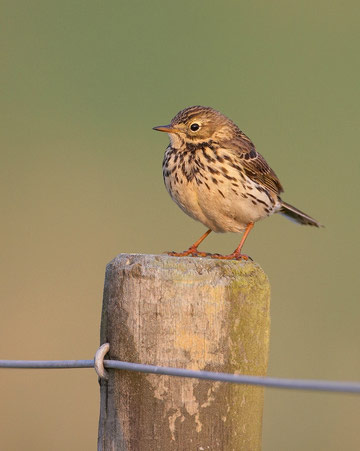
Meadow Pipit © Richard Steel
The Atlas map shows that wintering Meadow Pipits are distributed throughout the county, and they must be much more widespread now than they used to be. Older ornithologists wrote mainly about their status in freezing conditions. Coward and Oldham (1900) said that in hard winters the moorlands are deserted but a correspondent saw Meadow Pipits on the hills near the Cat and Fiddle in mild weather on 5 January 1899. It is also absent in winter from many parts of the plain, but on the Dee marshes and in the water meadows bordering the larger rivers it may be found all the year round. Coward (1910) added that hard weather drives the birds to the marshes, where, in severe frost they are very abundant. Boyd (1946) commented on a Meadow Pipit in January 1945 which lived for five days at the bottom of a ditch, ‘usually walking in the shallow water like a tiny wader; an odd choice for a bird which often leaves these islands for Portugal and southern Spain in winter’. Bell (1962) copied Coward’s description of the species’ seasonal status.
In winter Meadow Pipits seek out invertebrates, especially in sites such as sewage works, farmland slurry pits and the damp corners of fields, but otherwise eat almost any type of small seeds. Their ecology seems similar to that of Pied Wagtails, but pipits are much less likely to use human sites, and the map shows that few of the county’s urban tetrads had records of Meadow Pipits. Birds were present in about half of the upland breeding tetrads, some of them noted as returning early in spring, but others found in midwinter, although far fewer than during the breeding season.
With their substantial southward autumn movement, Meadow Pipit is one of the most obvious species for those watching visible migration, and the northern half of Britain – where most Meadow Pipits breed – is only sparsely occupied in winter (BTO Winter Atlas). The species’ traditional wintering grounds lie as far south as the Mediterranean but the destination of Cheshire and Wirral breeders is not known in our changing climate: as a partial migrant, the proportion staying in Britain is likely to have increased with the milder weather of the last two decades.
The winter habitat codes were scattered thinly across a wide range, but the vast majority (83%) were of farmland, with 7% semi-natural grassland and marsh. Cheshire farmland may be inhospitable for them in the breeding season, but in winter it is able to support Meadow Pipits. 41% of the total were improved grassland and 12% unimproved grassland, with 9% stubble. This is the small passerine with the highest number of records in unimproved grassland.
From the counts submitted by surveyors for this Atlas, the median flock size is ten birds, so the county wintering population of Meadow Pipits is at least 5,000 birds. By chance, this is much the same as the breeding population, but most of the birds are different individuals.
Sponsored by Jane Turner

